Quickstart: Provision a simulated TPM device
In this quickstart, you'll create a simulated device on your Windows machine. The simulated device will be configured to use a Trusted Platform Module (TPM) attestation mechanism for authentication. After you've configured your device, you'll provision it to your IoT hub using the Azure IoT Hub Device Provisioning Service. Sample code will then be used to help enroll the device with a Device Provisioning Service instance.
If you're unfamiliar with the process of provisioning, review the provisioning overview. Also make sure you've completed the steps in Set up IoT Hub Device Provisioning Service with the Azure portal before continuing.
The Azure IoT Device Provisioning Service supports two types of enrollments:
Enrollment groups that are used to enroll multiple related devices.
Individual Enrollments that are used to enroll a single device.
This article demonstrates individual enrollments.
Trusted Platform Module (TPM) attestation isn't supported in the Python SDK. With Python, you can provision a device using symmetric keys or X.509 certificates.
Prerequisites
If you don't have an Azure subscription, create a free account before you begin.
Complete the steps in Set up IoT Hub Device Provisioning Service with the Azure portal.
The following prerequisites are for a Windows development environment. For Linux or macOS, see the appropriate section in Prepare your development environment in the SDK documentation.
- Visual Studio 2019 with the 'Desktop development with C++' workload enabled. Visual Studio 2015 and Visual Studio 2017 are also supported.
A TPM 2.0 hardware security module on your Windows-based machine.
Install .NET Core SDK 6.0 or later on your Windows-based machine. You can use the following command to check your version.
dotnet --info
- Install Node.js v4.0+.
Install Java SE Development Kit 8 or later installed on your machine.
Download and install Maven.
- Install the latest version of Git. Make sure that Git is added to the environment variables accessible to the command window. See Software Freedom Conservancy's Git client tools for the latest version of
gittools to install, which includes Git Bash, the command-line app that you can use to interact with your local Git repository.
Prepare your development environment
In this section, you'll prepare a development environment used to build the Azure IoT C SDK and the TPM device simulator sample.
Download the latest CMake build system.
Important
Confirm that the Visual Studio prerequisites (Visual Studio and the 'Desktop development with C++' workload) are installed on your machine, before starting the
CMakeinstallation. Once the prerequisites are in place, and the download is verified, install the CMake build system. Also, be aware that older versions of the CMake build system fail to generate the solution file used in this article. Make sure to use the latest version of CMake.Open a web browser, and go to the Release page of the Azure IoT C SDK.
Select the Tags tab at the top of the page.
Copy the tag name for the latest release of the Azure IoT C SDK.
Open a command prompt or Git Bash shell. Run the following commands to clone the latest release of the Azure IoT Device SDK for C GitHub repository. Replace
<release-tag>with the tag you copied in the previous step, for example:lts_01_2023.git clone -b <release-tag> https://github.com/Azure/azure-iot-sdk-c.git cd azure-iot-sdk-c git submodule update --initThis operation could take several minutes to complete.
When the operation is complete, run the following commands from the
azure-iot-sdk-cdirectory:mkdir cmake cd cmake
Open a Git CMD or Git Bash command-line environment.
Clone the Azure IoT SDK for C# GitHub repository using the following command:
git clone https://github.com/Azure/azure-iot-sdk-csharp.git
Open a Git CMD or Git Bash command-line environment.
Clone the azure-utpm-c GitHub repository using the following command:
git clone https://github.com/Azure/azure-utpm-c.git --recursive
Open a Git CMD or Git Bash command-line environment.
Clone the Java GitHub repository using the following command:
git clone https://github.com/Azure/azure-iot-sdk-java.git --recursive
Build and run the TPM device simulator
In this section, you'll build and run the TPM simulator. This simulator listens over a socket on ports 2321 and 2322. Don't close the command window. You'll need to keep this simulator running until the end of this quickstart.
Run the following command to build Azure IoT C SDK that includes the TPM device simulator sample code. A Visual Studio solution for the simulated device is generated in the
cmakedirectory. This sample provides a TPM attestation mechanism via Shared Access Signature (SAS) Token authentication.cmake -Duse_prov_client:BOOL=ON -Duse_tpm_simulator:BOOL=ON ..Tip
If
cmakedoes not find your C++ compiler, you may get build errors while running the above command. If that happens, try running the command in the Visual Studio command prompt.When the build succeeds, the last few output lines look similar to the following output:
$ cmake -Duse_prov_client:BOOL=ON .. -- Building for: Visual Studio 16 2019 -- The C compiler identification is MSVC 19.23.28107.0 -- The CXX compiler identification is MSVC 19.23.28107.0 ... -- Configuring done -- Generating done -- Build files have been written to: C:/code/azure-iot-sdk-c/cmakeGo to the root folder of the git repository you cloned.
Run the TPM simulator using the path shown below.
cd .. .\provisioning_client\deps\utpm\tools\tpm_simulator\Simulator.exeThe simulator doesn't display any output. Let it continue to run as it simulates a TPM device.
Go to the GitHub root folder.
Run the TPM simulator to be the HSM for the simulated device.
.\azure-utpm-c\tools\tpm_simulator\Simulator.exeCreate a new empty folder called registerdevice. In the registerdevice folder, create a package.json file using the following command at your command prompt(make sure to answer all questions asked by
npmor accept the defaults if they suit you):npm initInstall the following precursor packages:
npm install node-gyp -g npm install ffi-napi -gNote
There are some known issues to installing the above packages. To resolve these issues, run
npm install --global --production windows-build-toolsusing a command prompt in Run as administrator mode, runSET VCTargetsPath=C:\Program Files (x86)\MSBuild\Microsoft.Cpp\v4.0\V140after replacing the path with your installed version, and then rerun the above installation commands.Install all required packages running the following command at your command prompt in the registerdevice folder:
npm install --save azure-iot-device azure-iot-device-mqtt azure-iot-security-tpm azure-iot-provisioning-device-http azure-iot-provisioning-deviceThe command installs the following packages:
A security client that works with TPM:
azure-iot-security-tpmA transport for the device to connect to the Device Provisioning Service: either
azure-iot-provisioning-device-httporazure-iot-provisioning-device-amqpA client to use the transport and security client:
azure-iot-provisioning-deviceThe device client:
azure-iot-deviceA transport: any of
azure-iot-device-amqp,azure-iot-device-mqtt, orazure-iot-device-httpThe security client that you already installed:
azure-iot-security-tpmNote
The samples in this quickstart use the
azure-iot-provisioning-device-httpandazure-iot-device-mqtttransports.
Open a text editor of your choices.
In the registerdevice folder, create a new ExtractDevice.js file.
Add the following
requirestatements at the start of the ExtractDevice.js file:'use strict'; var tpmSecurity = require('azure-iot-security-tpm'); var tssJs = require("tss.js"); var myTpm = new tpmSecurity.TpmSecurityClient(undefined, new tssJs.Tpm(true));Add the following function to implement the method:
myTpm.getEndorsementKey(function(err, endorsementKey) { if (err) { console.log('The error returned from get key is: ' + err); } else { console.log('the endorsement key is: ' + endorsementKey.toString('base64')); myTpm.getRegistrationId((getRegistrationIdError, registrationId) => { if (getRegistrationIdError) { console.log('The error returned from get registration id is: ' + getRegistrationIdError); } else { console.log('The Registration Id is: ' + registrationId); process.exit(); } }); } });Save and close the ExtractDevice.js file.
node ExtractDevice.jsRun the sample.
The output window displays the Endorsement key and the Registration ID needed for device enrollment. Copy these values.
Run the TPM simulator to be the HSM for the simulated device.
Select Allow Access. The simulator listens over a socket on ports 2321 and 2322. Don't close this command window; you need to keep this simulator running until the end of this quickstart guide.
.\azure-iot-sdk-java\provisioning\provisioning-tools\tpm-simulator\Simulator.exe
Open a second command prompt.
In the second command prompt, navigate to the root folder and build the sample dependencies.
cd azure-iot-sdk-java mvn install -DskipTests=trueNavigate to the sample folder.
cd provisioning/provisioning-samples/provisioning-tpm-sample
In this section, you'll build and execute a sample that reads the endorsement key and registration ID from the TPM simulator you left running, and is still listening over ports 2321 and 2322. These values will be used for device enrollment with your Device Provisioning Service instance.
Launch Visual Studio.
Open the solution generated in the cmake folder named
azure_iot_sdks.sln.On the Visual Studio menu, select Build > Build Solution to build all projects in the solution.
In Visual Studio's Solution Explorer window, navigate to the Provision_Tools folder. Right-click the tpm_device_provision project and select Set as Startup Project.
On the Visual Studio menu, select Debug > Start without debugging to run the solution. The app reads and displays a Registration ID and an Endorsement key. Note or copy these values. These will be used in the next section for device enrollment.
Sign in to the Azure portal, select the All resources button on the left-hand menu and open your Device Provisioning Service. Note your ID Scope and Provisioning Service Global Endpoint.

Edit
src/main/java/samples/com/microsoft/azure/sdk/iot/ProvisioningTpmSample.javato include your ID Scope and Provisioning Service Global Endpoint as noted before.private static final String idScope = "[Your ID scope here]"; private static final String globalEndpoint = "[Your Provisioning Service Global Endpoint here]"; private static final ProvisioningDeviceClientTransportProtocol PROVISIONING_DEVICE_CLIENT_TRANSPORT_PROTOCOL = ProvisioningDeviceClientTransportProtocol.HTTPS;Save the file.
Use the following commands to build the project, navigate to the target folder, and execute the created .jar file (replace
{version}with your version of Java):mvn clean install cd target java -jar ./provisioning-tpm-sample-{version}-with-deps.jarWhen the program begins running, it will display the Endorsement key and Registration ID. Copy these values for the next section. Make sure to leave the program running.
In this section, you'll build and execute a sample that reads the endorsement key from your TPM 2.0 hardware security module. This value will be used for device enrollment with your Device Provisioning Service instance.
In a command prompt, change directories to the project directory for the TPM device provisioning sample.
cd '.\azure-iot-sdk-csharp\provisioning\device\samples\how to guides\TpmSample\'Type the following command to build and run the TPM device provisioning sample. Copy the endorsement key returned from your TPM 2.0 hardware security module to use later when enrolling your device.
dotnet run -- -e
Sign in to the Azure portal and navigate to your Device Provisioning Service instance.
Select Manage enrollments from the Settings section of the navigation menu.
Select the Individual enrollments tab, then select Add individual enrollment.
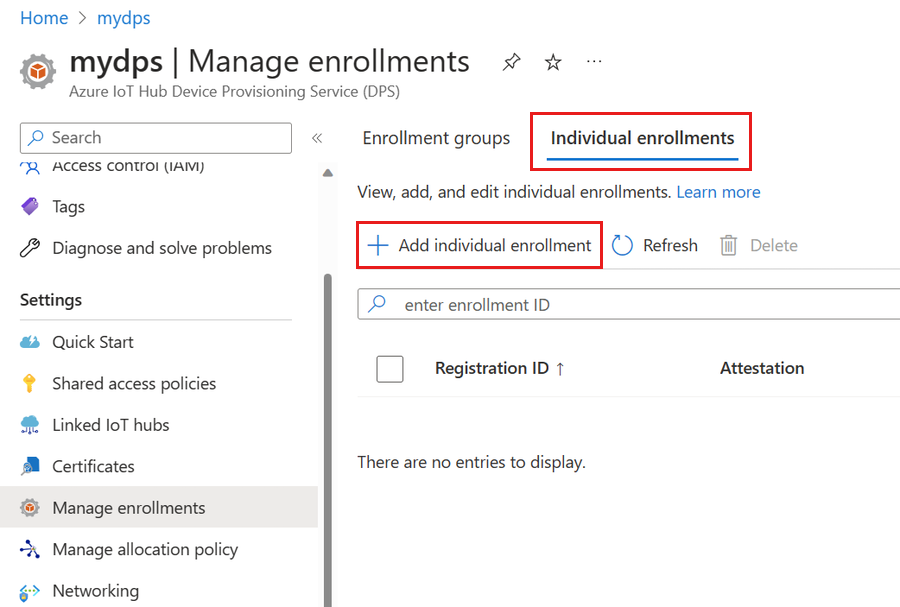
On the Registration + provisioning of the Add enrollment page, provide the following information to configure the enrollment details:
Field Description Attestation Select Trusted Platform Module (TPM) as the Attestation mechanism. Trusted Platform Module (TPM) settings Provide the endorsement key that will be used to verify the device for this enrollment. You can retrieve the endorsement key from your device's TPM. Registration ID Provide the unique registration ID for the device. You can retrieve the registration ID from your device's TPM. Provisioning status Check the Enable this enrollment box if you want this enrollment to be available to provision its device. Uncheck this box if you want the enrollment to be disabled. You can change this setting later. Reprovision policy Choose a reprovision policy that reflects how you want DPS to handle devices that request reprovisioning. For more information, see Reprovision policies. Select Next: IoT hubs.
On the IoT hubs tab of the Add enrollment page, provide the following information to determine which IoT hubs the enrollment can provision devices to:
Field Description Target IoT hubs Select one or more of your linked IoT hubs, or add a new link to an IoT hub. To learn more about linking IoT hubs to your DPS instance, see How to link and manage IoT hubs. Allocation policy If you selected more than one linked IoT hub, select how you want to assign devices to the different hubs. To learn more about allocation policies, see How to use allocation policies.
If you selected only one linked IoT hub, we recommend using the Evenly weighted distribution policy.Select Next: Device settings
On the Device settings tab of the Add enrollment page, provide the following information to define how newly provisioned devices will be configured:
Field Description Device ID Provide a device ID that will be assigned to the provisioned device in IoT Hub. If you don't provide a device ID, the registration ID will be used. IoT Edge Check the Enable IoT Edge on provisioned devices if the provisioned device will run Azure IoT Edge. Uncheck this box if this enrollment is for a non-IoT Edge-enabled device. Device tags Use this text box to provide any tags that you want to apply to the device twin of the provisioned device. Desired properties Use this text box to provide any desired properties that you want to apply to the device twin of the provisioned device. For more information, see Understand and use device twins in IoT Hub.
Select Next: Review + create.
On the Review + create tab, verify all of your values then select Create.
The C# TPM sample for this quickstart doesn't provide a registration ID. When prompted to add one for the individual enrollment, provide your own value.
Sign in to the Azure portal and navigate to your Device Provisioning Service instance.
Select Manage enrollments from the Settings section of the navigation menu.
Select the Individual enrollments tab, then select Add individual enrollment.

On the Registration + provisioning of the Add enrollment page, provide the following information to configure the enrollment details:
Field Description Attestation Select Trusted Platform Module (TPM) as the Attestation mechanism. Trusted Platform Module (TPM) settings Provide the endorsement key that will be used to verify the device for this enrollment. You can retrieve the endorsement key from your device's TPM. Registration ID Provide the unique registration ID for the device. You can retrieve the registration ID from your device's TPM. Provisioning status Check the Enable this enrollment box if you want this enrollment to be available to provision its device. Uncheck this box if you want the enrollment to be disabled. You can change this setting later. Reprovision policy Choose a reprovision policy that reflects how you want DPS to handle devices that request reprovisioning. For more information, see Reprovision policies. Select Next: IoT hubs.
On the IoT hubs tab of the Add enrollment page, provide the following information to determine which IoT hubs the enrollment can provision devices to:
Field Description Target IoT hubs Select one or more of your linked IoT hubs, or add a new link to an IoT hub. To learn more about linking IoT hubs to your DPS instance, see How to link and manage IoT hubs. Allocation policy If you selected more than one linked IoT hub, select how you want to assign devices to the different hubs. To learn more about allocation policies, see How to use allocation policies.
If you selected only one linked IoT hub, we recommend using the Evenly weighted distribution policy.Select Next: Device settings
On the Device settings tab of the Add enrollment page, provide the following information to define how newly provisioned devices will be configured:
Field Description Device ID Provide a device ID that will be assigned to the provisioned device in IoT Hub. If you don't provide a device ID, the registration ID will be used. IoT Edge Check the Enable IoT Edge on provisioned devices if the provisioned device will run Azure IoT Edge. Uncheck this box if this enrollment is for a non-IoT Edge-enabled device. Device tags Use this text box to provide any tags that you want to apply to the device twin of the provisioned device. Desired properties Use this text box to provide any desired properties that you want to apply to the device twin of the provisioned device. For more information, see Understand and use device twins in IoT Hub.
Select Next: Review + create.
On the Review + create tab, verify all of your values then select Create.
Register the device
In this section, you'll configure sample code to use the Advanced Message Queuing Protocol (AMQP) to send the device's boot sequence to your Device Provisioning Service instance. This boot sequence causes the device to be registered to an IoT hub linked to the Device Provisioning Service instance.
In the Azure portal, select the Overview tab for your Device Provisioning Service.
Copy the ID Scope value.
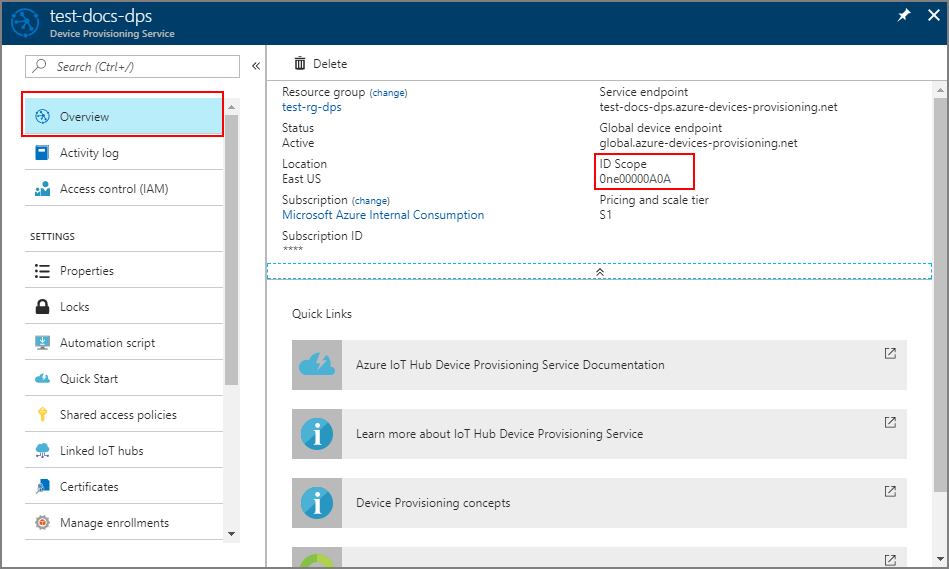
In Visual Studio's Solution Explorer window, navigate to the Provision_Samples folder. Expand the sample project named prov_dev_client_sample. Expand Source Files, and open prov_dev_client_sample.c.
Near the top of the file, find the
#definestatements for each device protocol as shown below. Make sure onlySAMPLE_AMQPis uncommented.Currently, the MQTT protocol isn't supported for TPM Individual Enrollment.
// // The protocol you wish to use should be uncommented // //#define SAMPLE_MQTT //#define SAMPLE_MQTT_OVER_WEBSOCKETS #define SAMPLE_AMQP //#define SAMPLE_AMQP_OVER_WEBSOCKETS //#define SAMPLE_HTTPFind the
id_scopeconstant, and replace the value with your ID Scope value that you copied earlier.static const char* id_scope = "0ne00002193";Find the definition for the
main()function in the same file. Make sure thehsm_typevariable is set toSECURE_DEVICE_TYPE_TPMas shown below.SECURE_DEVICE_TYPE hsm_type; hsm_type = SECURE_DEVICE_TYPE_TPM; //hsm_type = SECURE_DEVICE_TYPE_X509; //hsm_type = SECURE_DEVICE_TYPE_SYMMETRIC_KEY;Right-click the prov_dev_client_sample project and select Set as Startup Project.
On the Visual Studio menu, select Debug > Start without debugging to run the solution. In the prompt to rebuild the project, select Yes, to rebuild the project before running.
The following output is an example of the provisioning device client sample successfully booting up, and connecting to a Device Provisioning Service instance to get IoT hub information and registering:
Provisioning API Version: 1.2.7 Registering... Press enter key to interrupt. Provisioning Status: PROV_DEVICE_REG_STATUS_CONNECTED Provisioning Status: PROV_DEVICE_REG_STATUS_ASSIGNING Provisioning Status: PROV_DEVICE_REG_STATUS_ASSIGNING Registration Information received from service: test-docs-hub.azure-devices.net, deviceId: test-docs-cert-device
In the Azure portal, select the Overview tab for your Device Provisioning Service.
Copy the ID Scope value.
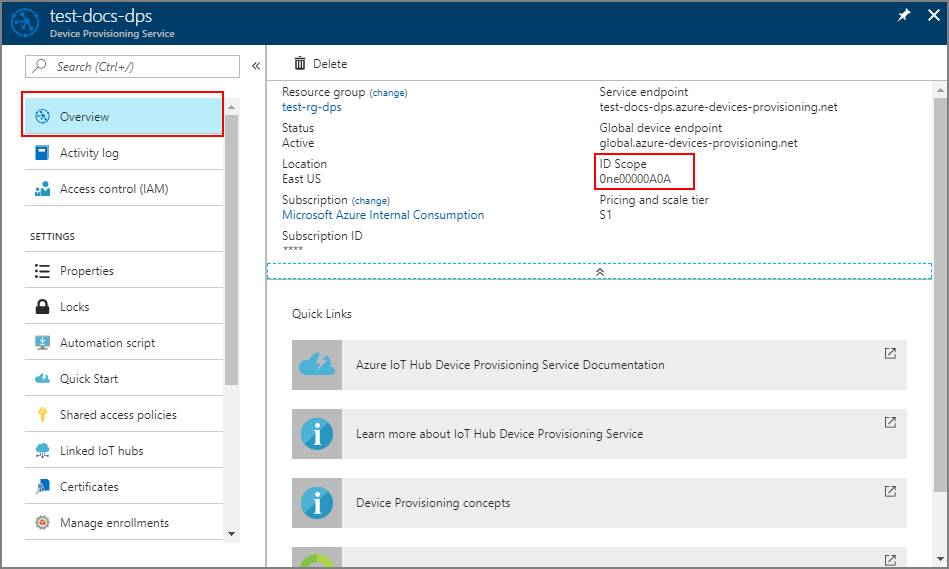
In a command prompt, change directories to the project directory for the TPM device provisioning sample.
cd '.\azure-iot-sdk-csharp\provisioning\device\samples\how to guides\TpmSample\'Run the following command to register your device. Replace
<IdScope>with the value for the DPS you copied and<RegistrationId>with the value you used when creating the device enrollment.dotnet run -- -s <IdScope> -r <RegistrationId>If the device registration was successful, you'll see the following messages:
Initializing security using the local TPM... Initializing the device provisioning client... Initialized for registration Id <RegistrationId>. Registering with the device provisioning service... Registration status: Assigned. Device <RegistrationId> registered to <HubName>.azure-devices.net. Creating TPM authentication for IoT Hub... Testing the provisioned device with IoT Hub... Sending a telemetry message... Finished.
In the Azure portal, select the Overview tab for your Device Provisioning Service.
Copy the ID Scope value.
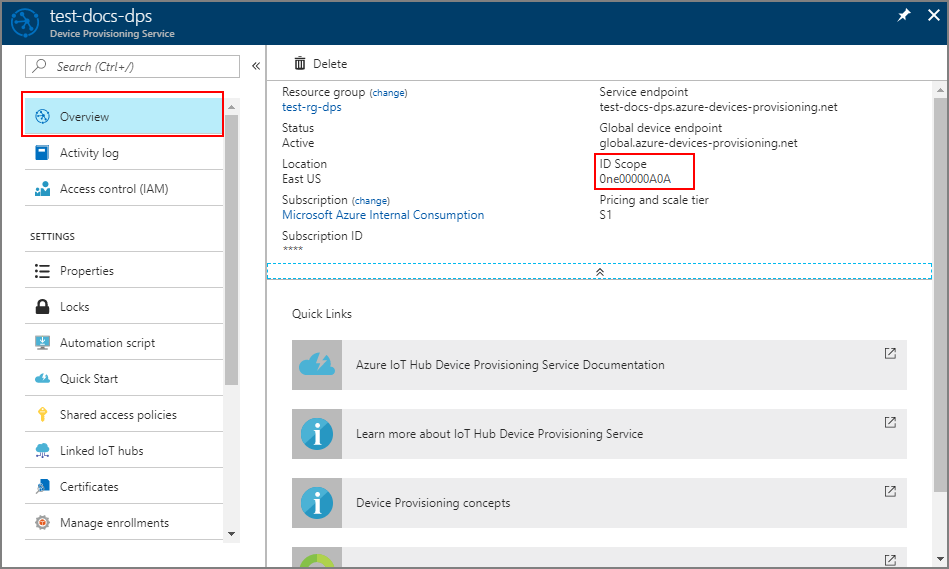
Open a text editor of your choice.
In the registerdevice folder, create a new RegisterDevice.js file.
Add the following
requirestatements at the start of the RegisterDevice.js file:'use strict'; var ProvisioningTransport = require('azure-iot-provisioning-device-http').Http; var iotHubTransport = require('azure-iot-device-mqtt').Mqtt; var Client = require('azure-iot-device').Client; var Message = require('azure-iot-device').Message; var tpmSecurity = require('azure-iot-security-tpm'); var ProvisioningDeviceClient = require('azure-iot-provisioning-device').ProvisioningDeviceClient;Note
The Azure IoT SDK for Node.js supports additional protocols like AMQP, AMQP WS, and MQTT WS. For more examples, see Device Provisioning Service SDK for Node.js samples.
Add globalDeviceEndpoint and idScope variables and use them to create a ProvisioningDeviceClient instance. Replace {globalDeviceEndpoint} and {idScope} with the Global Device Endpoint and ID Scope values from Step 1:
var provisioningHost = '{globalDeviceEndpoint}'; var idScope = '{idScope}'; var tssJs = require("tss.js"); var securityClient = new tpmSecurity.TpmSecurityClient('', new tssJs.Tpm(true)); // if using non-simulated device, replace the above line with following: //var securityClient = new tpmSecurity.TpmSecurityClient(); var provisioningClient = ProvisioningDeviceClient.create(provisioningHost, idScope, new ProvisioningTransport(), securityClient);Add the following function to implement the method on the device:
provisioningClient.register(function(err, result) { if (err) { console.log("error registering device: " + err); } else { console.log('registration succeeded'); console.log('assigned hub=' + result.registrationState.assignedHub); console.log('deviceId=' + result.registrationState.deviceId); var tpmAuthenticationProvider = tpmSecurity.TpmAuthenticationProvider.fromTpmSecurityClient(result.registrationState.deviceId, result.registrationState.assignedHub, securityClient); var hubClient = Client.fromAuthenticationProvider(tpmAuthenticationProvider, iotHubTransport); var connectCallback = function (err) { if (err) { console.error('Could not connect: ' + err.message); } else { console.log('Client connected'); var message = new Message('Hello world'); hubClient.sendEvent(message, printResultFor('send')); } }; hubClient.open(connectCallback); function printResultFor(op) { return function printResult(err, res) { if (err) console.log(op + ' error: ' + err.toString()); if (res) console.log(op + ' status: ' + res.constructor.name); process.exit(1); }; } } });Save and close the RegisterDevice.js file.
Run the following command:
node RegisterDevice.jsNotice the messages that simulate the device booting and connecting to the Device Provisioning Service to get your IoT hub information.
In the command window running the Java sample code on your machine, press Enter to continue running the application. Notice the messages that simulate the device booting and connecting to the Device Provisioning Service to get your IoT hub information.

Confirm your device provisioning registration
Sign in to the Azure portal.
On the left-hand menu or on the portal page, select All resources.
Select the IoT hub to which your device was assigned.
In the Explorers menu, select IoT Devices.
If your device was provisioned successfully, the device ID should appear in the list, with Status set as enabled. If you don't see your device, select Refresh at the top of the page.
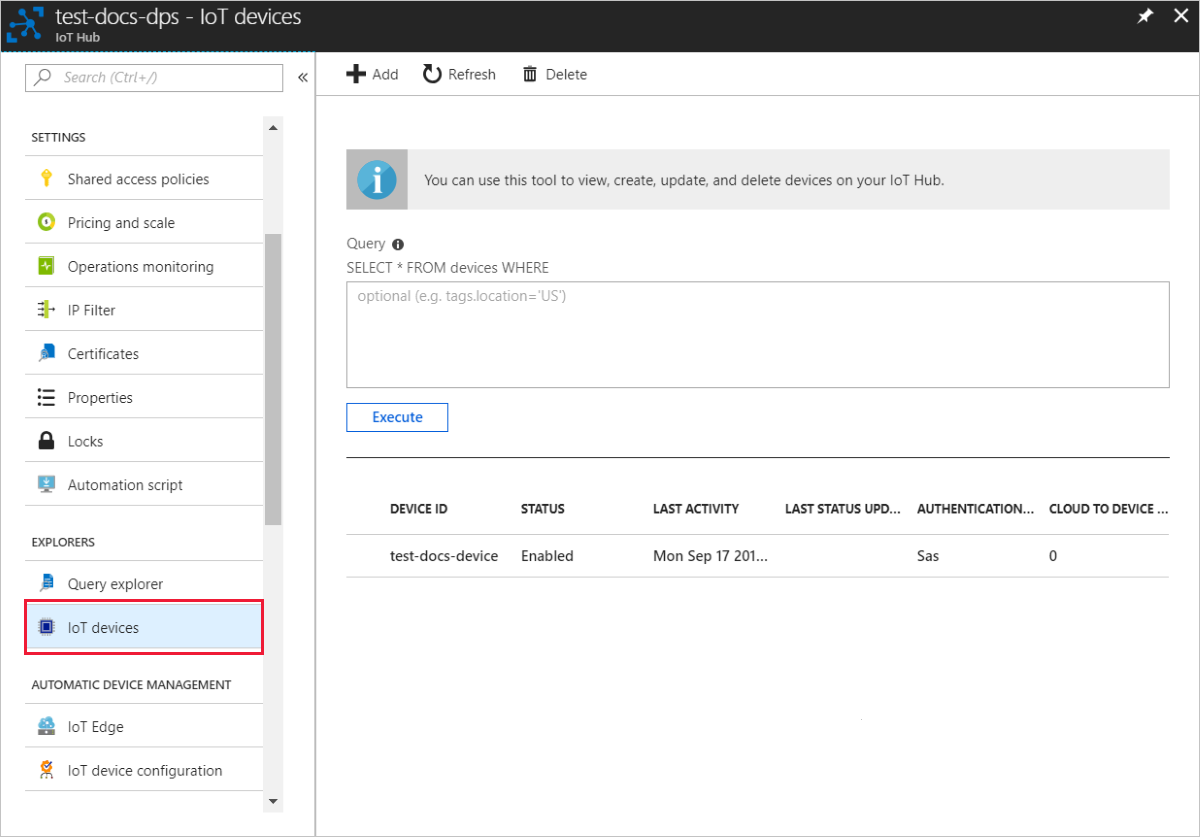
If your device was provisioned successfully, the device ID should appear in the list, with Status set as enabled. If you don't see your device, select Refresh at the top of the page.

If your device was provisioned successfully, the device ID should appear in the list, with Status set as enabled. If you don't see your device, select Refresh at the top of the page.
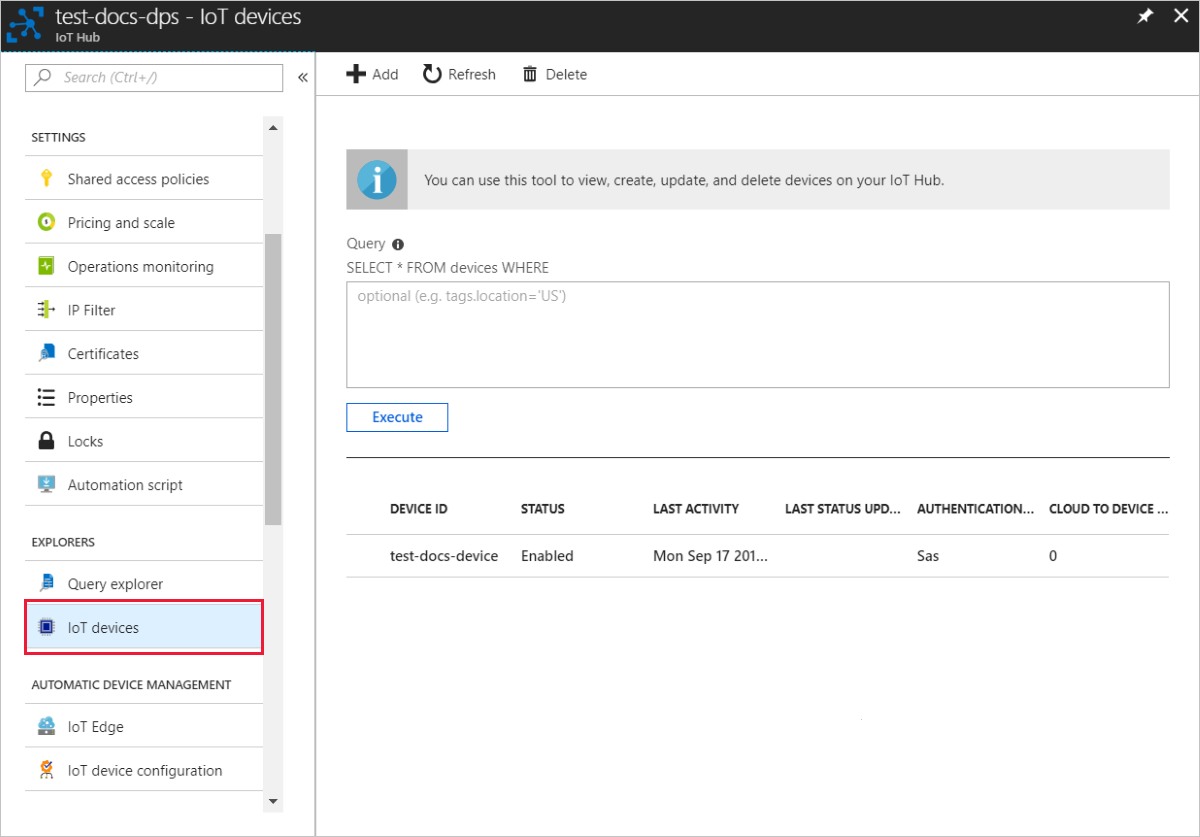
If your device was provisioned successfully, the device ID should appear in the list, with Status set as enabled. If you don't see your device, select Refresh at the top of the page.
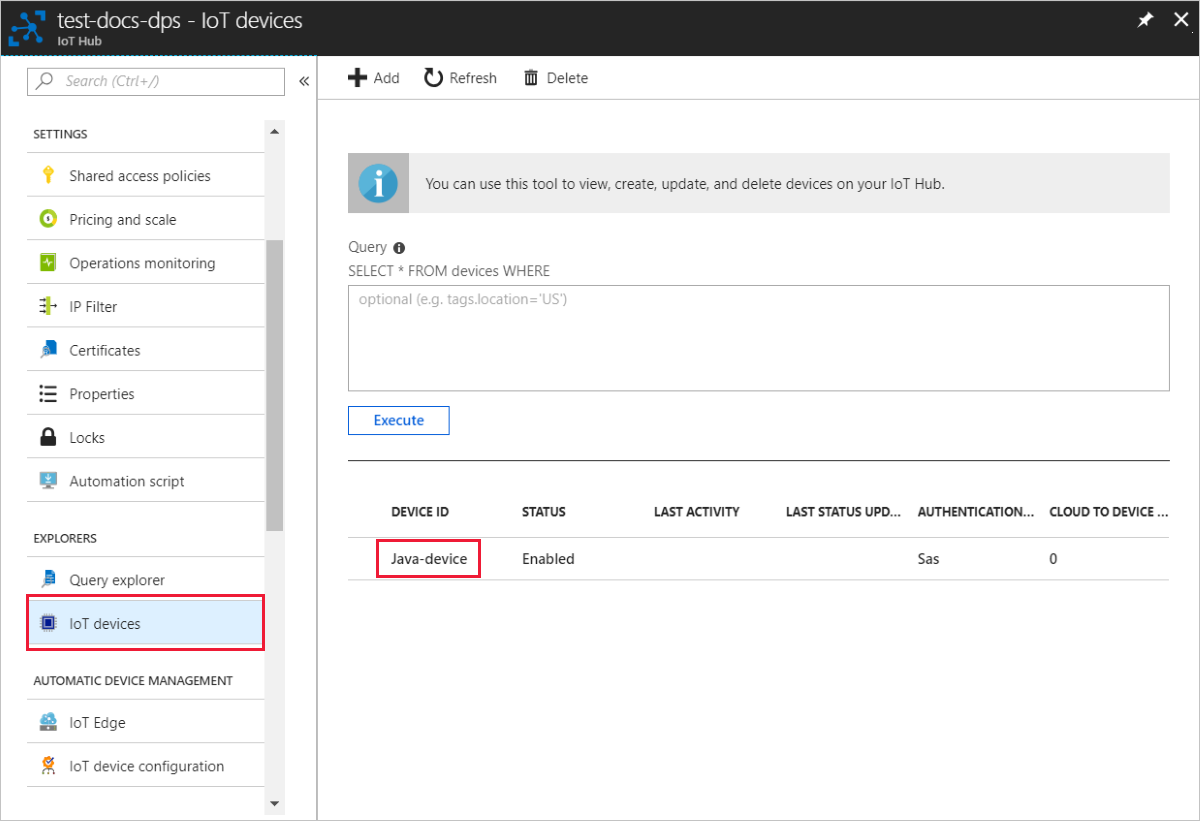
Note
If you changed the initial device twin state from the default value in the enrollment entry for your device, it can pull the desired twin state from the hub and act accordingly. For more information, see Understand and use device twins in IoT Hub.
Clean up resources
If you plan to continue working on and exploring the device client sample, don't clean up the resources created in this quickstart. If you don't plan to continue, use the following steps to delete all resources created by this quickstart.
Delete your device enrollment
Close the device client sample output window on your machine.
From the left-hand menu in the Azure portal, select All resources.
Select your Device Provisioning Service.
In the Settings menu, select Manage enrollments.
Select the Individual enrollments tab.
Select the check box next to the registration ID of the device you enrolled in this quickstart.
At the top of the page, select Delete.
Delete your device registration from IoT Hub
From the left-hand menu in the Azure portal, select All resources.
Select your IoT hub.
In the Explorers menu, select IoT devices.
Select the check box next to the device ID of the device you registered in this quickstart.
At the top of the page, select Delete.
Next steps
In this quickstart, you provisioned a single device to your IoT hub using an individual enrollment. Next, learn how to provision multiple devices across multiple hubs.